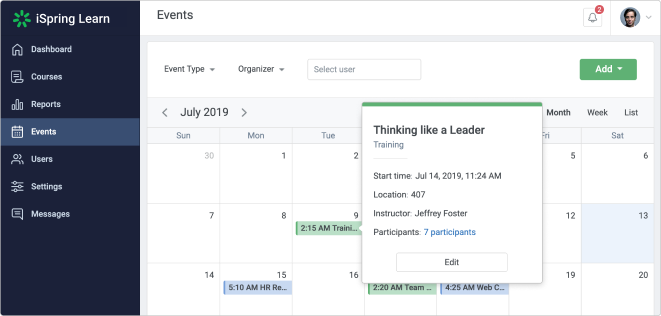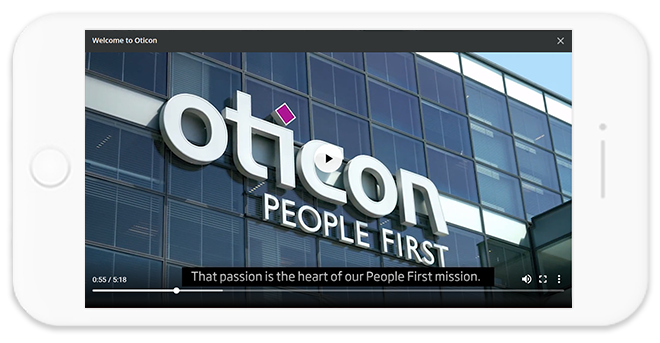70:20:10 Learning Model: How to Enhance It with Technology

Learning is like a pie. To make it tasty, you need to know which ingredients to add and in what proportions. The 70:20:10 model is a magic recipe for corporate learning.
With the help of Dr Anthony Skip Basiel, an eLearning research and development thought leader with 20 years of experience in UK higher education, we’ve figured out how this formula works and how to apply it in the workplace.
What Is the 70:20:10 Rule?
The 70:20:10 learning model was developed by Morgan McCall, Robert Eichinger, and Michael Lombardo at the Center for Creative Leadership in the mid-1990s. They surveyed almost 200 executives about their learning philosophy. The results were pretty surprising, and caused a notable shift in the learning world.
The survey states that learning should come from a variety of sources:
- 70% from challenging assignments;
- 20% from developmental relationships;
- 10% from coursework and training.
It’s been a while since then, yet the 70:20:10 model has stood the test of time, and is still often used to define the ideal balance for how to train employees. Let’s translate the survey data into corporate language and try to understand how to apply it in a work environment.
- 70% of learning is experiential. It comes from experiences employees face at work.
- 20% is social or peer-to-peer learning. This is accomplished through mentoring, feedback, and relationships with colleagues.
Together, these two types comprise informal learning, which occurs outside a classroom environment.
- 10% is formal learning. It is conducted through training sessions.
Benefits of Using the 70:20:10 Learning Model
Now that you know what the 70:20:10 framework represents in the corporate environment, let’s see why many L&D professionals find it beneficial.
- Flexibility. Businesses can use it in different ways, depending on their needs. You can use it to achieve specific outcomes like driving employee productivity, or utilize it strategically to help with wider learning, like continuous professional development.
- Faster productivity and performance. This model is mostly defined as an informal training method that often proves more efficient. Sometimes it’s better to ask a colleague and have an issue solved on the spot, as opposed to waiting for a training course. Or, instead of sending employees to a training session, especially to another city, you can assign a mentor who will share their knowledge and experience and help others progress in their work faster.
- Higher employee retention. The 70:20:10 model assumes that managers and other employees get involved in training. And this is an important factor that makes the staff want to stay with the company.
How to Implement the 70:20:10 Learning Model in Your Learning Workflow
Now we’ll consider each ingredient of the learning “pie” in greater detail and see how you can enhance each of them with modern technologies. Let’s start with big to small and find out what experiential learning means.
Experiential Learning (70%)
Just as children learn through play, adults learn best by doing. According to a study conducted by Edgar Dale, adults retain 80% of what they personally experience. So, this part of the 70:20:10 model suggests that you can’t learn anything if you don’t try it first. However, sometimes, instead of learning in a real-life situation, you can use certain innovative ways to develop your skills.
How to enhance learning with technology
Virtual Reality
Virtual reality is an ideal solution for corporate training in manufacturing, energy, defense, and other industries where the workplace can be dangerous. With VR, people can practice their skills until they are confident in them, and then start the job with confidence.
For example, The Palm Beach Gardens Fire Rescue department in Florida uses VR to prepare trainees for real-life emergencies. During the simulation, potential firefighters need to rescue people from a virtual fire and provide first aid.
Augmented Reality
Augmented reality can drive employee engagement just as much as virtual reality. But compared to VR, it’s much more affordable. That’s the reason why AR technology is most often used for training.
AR is especially promising in the area of medical education. Use cases of AR technology include creating human body models that allow medical students to learn anatomy and simulations like practicing surgeries on virtual patients.

Dr Anthony Skip Basiel
Interactive video
Another way to develop tacit knowledge is through web video that employs scenario-based learning design. This case-study approach provides open situations for the learner to make decisions and reflect on the process. The interaction comes from places in the ‘story’ where there is a choice to be made. The learner’s prior knowledge and decisions result in meaningful consequences.
See an example of an interactive video with this CPR simulation.
Social Learning (20%)
Social learning is not a new notion. Information has been handed down from generation to generation since time immemorial. We learn when we talk to other people, ask questions, and share our knowledge. In recent years, the concept of peer-to-peer learning has been gaining popularity as an accepted practice in the workplace.
How to enhance learning with technology
Social media
In the modern interconnected world dominated by social media, it’s become par for the course to share things we find interesting and useful. People use social media not only for personal communication, but also for professional and pedagogical purposes. For example, with Facebook, you can:
- create discussion groups for sharing information about a project;
- carry out surveys to get feedback and suggestions on training courses;
- create closed or secret groups and upload course material and assignments.
For instance, PayPal has a private group on Facebook where mentors upload learning content and host short classes, and employees share their insights and discuss recent information on ongoing projects.
Some educators use YouTube for employee learning. For example, IBM have an entire YouTube channel where employees can watch video tutorials and other learning materials.

Dr Anthony Skip Basiel
Learner-generated content
Another variation of social employee learning is the British Telecom project: Dare-to-share. Staff were encouraged to identify issues they encounter at work. Using smartphones, they make short videos to explain how they solved a problem and show what to do. Not only is this bottom-up, learner-generated Web 2.0 model a shift in ownership of content, it helps employees become evangelists to promote their knowledge.
Formal Learning (10%)
Though formal training makes up only 10% of the 70:20:10 model, it’s the starting point from which other types of learning can grow. If the foundation is firm, you can be sure that the experiential and peer-to-peer learning that follows will be successful.
Formal learning is the knowledge upon which informal learning is built. However, it also can act as a booster, accelerating what has been learned through on-the-job experience and interpersonal communication, so it can be used as a supportive tool for achieving good learning results.
How to enhance learning with technology
eLearning
Not so long ago, employees were sent off to classroom courses for training, but eLearning technology is making traditional corporate learning a thing of the past. Compared to instructor-led training, online learning is more beneficial. At the very least, it saves your company money, allows you to personalize the learning process, and boosts employee morale.
A better way to deliver formal learning is to use a learning management system (LMS). Let’s take iSpring Learn LMS as an example to see how to organize online training in just three steps:
- Create a learning program, which may include PPT presentations, documents, audio, video and SCORM courses.
- Add learners and assign them to the courses.
- Keep track of your employees’ results and measure the effectiveness of the training.
Using an LMS is a good idea for delivering product knowledge training, sales and support skills training, new hire orientation, and channel partner training. To learn how it works, read this article about corporate LMSs.
Blended learning
Blended learning is a formal educational program that combines traditional teaching methods with digital learning.
For instance, this approach is used by a large iron and steel company called NLMK. They created a talent pipeline training program that they use to develop high-potential employees for the position of foreman. At first, employees go through face-to-face training on key efficiency indicators. Then, they view courses on the NLMK Group facilities, the production process flow, the internal business processes, and key regulations. In the final stage, employees have a mix of online courses and in-class training on soft skills.
Here, an LMS can be helpful, not only for delivering online training, but also for scheduling face-to-face classes. For example, iSpring Learn LMS has a calendar that allows employees to see which events are planned, automatically invites learners, reminds them about the event, and drops them a line if there are any changes.


Dr Anthony Skip Basiel
Webinars
Web video conferencing is a powerful way to promote blended social learning. Many webinar platforms support live video, text chat interactive whiteboards, note-taking, real-time voting/surveys/quizzes, and PowerPoint slides. Plus, sessions can be recorded to capture the event for people who missed the webinar or want to revisit it. This is a great way to support your virtual teams.
Mobile learning
Many employees believe that training doesn’t have to stop after working hours. Also, most employees value the ability to learn anytime and anywhere, so mobile learning is a win-win both for companies and the people they employ.
Some companies have already learned from their own experience that it’s much more effective to let your employees take a course remotely, on their own schedule, than to keep them chained to their desks after work.
For example, Oticon, Inc., the global hearing aid manufacturer, allows their employees to learn at their own pace from mobile devices. They train their staff with iSpring Learn LMS, which has a free native mobile app. With the app, learners can take courses anytime and anywhere, even offline.

If you’re considering adopting mLearning in your company, read our guide about how to create a mobile learning strategy.
How to Create a 70-20-10 Development Plan
If the 70-20-10 framework is a brand-new approach for your organization, it can be hard to implement. And this is where you need a well-developed plan. A strategic plan will help you set specific training goals to achieve them faster and prepare a realistic vision of how this learning model will work in your corporate environment. So let’s see which specific steps to take to make the process run more smoothly.
Define goals and expected training outcomes
What is the application of the 70-20-10 rule in your workforce training environment intended to address? Is it a performance gap? Is it a knowledge gap? Is it to master a skill that will make the staff more productive? Regardless, you need to define the purpose – why you need to implement it – and make sure it is clear and really worth the investment of time and money.
After you have defined an overall goal, establish expected training outcomes – what must your employees achieve at the end of the training. For example, if your purpose is to improve the performance of your customer service agents, you might set up the following outcomes:
- Employees have perfect knowledge of all the company’s products and services
- They can handle upset customers and turn negative situations into positive experiences
- Customer service agents use their posture and body language to improve the interaction with clients
Develop a strategy
In order to achieve the organization’s goals and objectives through the 70-20-10 model, you need to align each outcome you want to accomplish with a specific type of learning (experiential, social, or formal) and a training method (e.g., eLearning, mentoring, or virtual reality).
Let’s return to our customer service training theme. To help your team improve their product knowledge, you can enroll them in an online course that will provide all the necessary information about a product. To teach them the right body language, you can assign a mentor. And if you want your customer service agents to improve their communication skills and learn to handle difficult client situations with ease, you can train them with role-playing scenarios, either face to face or online.
Also read: Mentorship Program: All You Should to Know in 2023 [Expert Insights]
Invest in the right tools
Now that you know exactly what goals you want to reach and how you want to reach them, it’s time to decide what tools you need in order to bring your plan to life. See what you already have in place and define the gaps that you need to fill. Here are some tools you may need:
- A learning management system (LMS). As we’ve already mentioned, an LMS helps you effectively deliver, manage, and track employee training. This is a necessary tool if you want to automate training and be able to assess your team members’ results.
- A web conferencing/webinar platform. Some LMSs are integrated with such platforms. However, if this is not your case or you need only a web conferencing software for your training needs, here are some popular solutions: Zoom, WebEx’s GoToMeeting, and JoinMe.
- An eLearning authoring tool. This is what you need if you’re going to create online courses in-house. For example, with the iSpring Suite authoring toolkit, you can build interactive courses with quizzes, videos, and dialog simulations. And the best thing is that this toolkit doesn’t require any technical skills or experience in instructional design – you can start creating the learning content with no prior training.
- A communication tool. Messaging apps like Slack, social media services like Facebook Workplace, and tools for hosting video meetings like Zoom, can help streamline social learning.
A project management tool. To manage training projects and deliver them on time and within your budget may not be that easy. This is where a project management tool can help. Tools like Trello, Workzone, and Proofhub can help you ensure that all training tasks are assigned to teammates on time and deadlines are met.
Now that you have a well-developed implementation plan and all the necessary tools, you can proceed to develop the training program. Check out our guide on how to create an online course.
To Sum Up
The 70:20:10 model shows that learning is more than just traditional classes. We need several ingredients to make it work. Also, you should keep in mind that this model is not just about the exact percentages, it’s about the balance. In real life, the breakdown may be more like 40% formal, 20% social, and 40% experiential; or 60% experiential, 10% social, and 30% formal, etc. Thanks to modern technology, the 70:20:10 framework can be more flexible than ever before. The best thing to do is to find the ideal balance between the ingredients to make the “learning” pie taste best.
About the expert

Dr Anthony Skip Basiel
Dr Anthony Skip Basiel is an eLearning research and development thought leader with twenty years of experience in UK Higher Education.
“My knowledge and capability in learning and development has grown from an innovative blend of higher education and industry through work-based learning. I have leadership, project and talent management skills developed through clear communication and professional collaboration.
As a Sr Postgraduate Programme Leader, eLearning Consultant, UK/EC Project Manager & bid writer, I worked at a strategic level to lead change management actions that saved time and money for the organization.”




